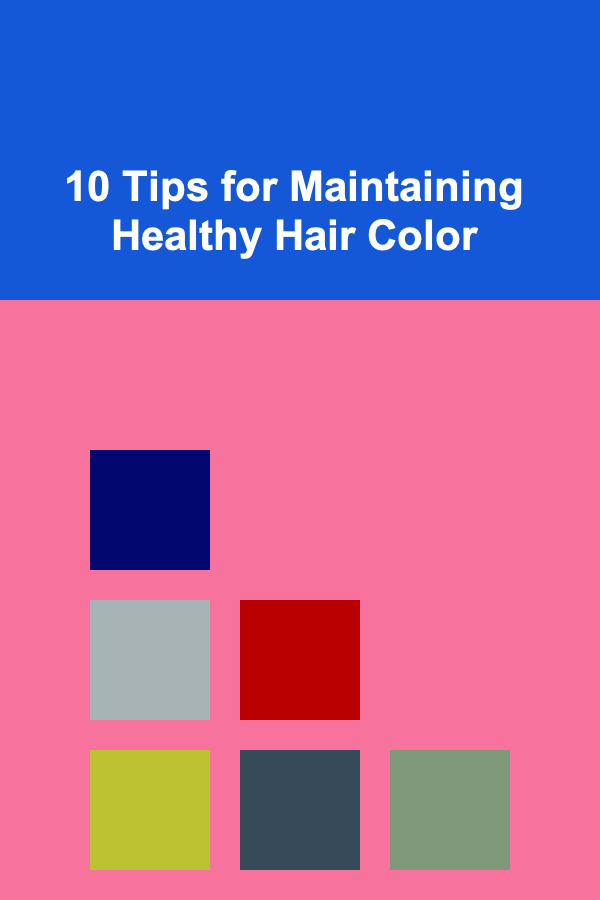
10 Tips for Maintaining Healthy Hair Color
ebook include PDF & Audio bundle (Micro Guide)
$12.99$11.99
Limited Time Offer! Order within the next:

Maintaining vibrant, healthy hair color is a priority for many people who opt for hair dye treatments. Whether you prefer bold shades, subtle highlights, or a natural-looking enhancement, keeping your color fresh and your hair in optimal condition requires effort, knowledge, and the right products. As your hair goes through chemical processes, proper care becomes essential to avoid damage and to extend the life of your color. In this article, we'll cover 10 essential tips for maintaining healthy hair color, helping you keep your locks looking their best.
Choose the Right Hair Dye for Your Hair Type
The first step to ensuring the longevity of your color is to select a dye that suits your hair type and condition. Not all dyes are created equal, and some may cause more harm than good depending on your hair texture, porosity, and previous damage.
Tip:
- Semi-permanent vs. Permanent: Semi-permanent dyes are gentler on the hair, as they don't contain ammonia or peroxide, which can be damaging. However, they fade more quickly. On the other hand, permanent hair dyes provide long-lasting results but tend to be more damaging. If you're looking to minimize damage, consider opting for a semi-permanent or ammonia-free dye.
- Hair Texture: Coarser or thicker hair may require a different dye formula than finer hair. Check product labels to ensure compatibility with your hair texture.
Selecting the right hair dye for your specific hair type will help ensure that your color is vibrant, your hair stays healthy, and the dye job lasts longer.
Protect Your Hair from the Sun
Exposure to the sun's UV rays can cause your hair color to fade prematurely. The sun's harmful rays break down the dye molecules, making your color dull and lifeless. Moreover, UV exposure can also dry out the hair and weaken its strands, leading to breakage.
Tip:
- Use hair products that contain UV protection , or wear a hat to shield your hair from direct sunlight when possible.
- Leave-in conditioners and styling products with SPF can provide an extra layer of defense for your hair.
By protecting your hair from the sun, you can maintain the vibrancy of your color while preserving the integrity of the hair itself.
Avoid Over-Washing Your Hair
Frequent washing strips the hair of its natural oils, which can make your color fade faster. Shampooing too often also removes the hair dye, leaving your hair looking dull and dry. The chemicals in shampoos can further strip your hair of essential moisture, making it prone to breakage.
Tip:
- Try washing your hair 2-3 times a week instead of every day. For dry or curly hair, consider washing even less frequently.
- Use a dry shampoo between washes to refresh your hair and add volume without losing moisture.
The less often you wash your hair, the longer your color will last. Using dry shampoo also helps maintain cleanliness and volume without over-exposing the hair to cleansing agents.
Use Sulfate-Free Shampoo
Sulfates are harsh cleansing agents commonly found in many shampoos. They are effective at removing oils and dirt but can also strip away hair dye and moisture from your strands, leading to quicker color fading and dryness.
Tip:
- Look for sulfate-free shampoos specifically designed for color-treated hair. These shampoos gently cleanse without stripping your color.
- Consider using a shampoo formulated for colored hair, as these products contain ingredients that are gentle and protect the integrity of the dye.
By switching to sulfate-free products, you can extend the life of your hair color while keeping your hair soft, shiny, and healthy.
Deep Condition Regularly
Coloring your hair can leave it more vulnerable to damage, as the chemical process often weakens hair strands. Deep conditioning treatments are essential for keeping hair moisturized, nourished, and strong. These treatments help restore moisture and prevent split ends, which can make the color appear lackluster.
Tip:
- Apply a deep conditioning mask once a week to restore moisture. Look for products that contain ingredients like argan oil , keratin , or coconut oil for added nourishment.
- If your hair is particularly dry or damaged, use a leave-in conditioner that can provide continuous hydration throughout the day.
Deep conditioning not only helps preserve the appearance of your color but also prevents the breakage and dryness that can arise from regular dyeing.
Rinse with Cool Water
Hot water opens the cuticle of the hair shaft, allowing the color to escape more quickly. This causes the color to fade faster and can lead to a dry, frizzy texture. Rinsing your hair with cool water, however, helps seal the cuticle and locks in the color.
Tip:
- Cool or lukewarm water is ideal for washing and rinsing color-treated hair.
- After applying conditioner, rinse with cool water to help smooth the cuticle and maintain color longevity.
By switching to cooler water temperatures, you can keep your hair shiny and vibrant for a longer period, while also helping to preserve the strength and health of your strands.
Trim Your Hair Regularly
Regular hair trims are important for maintaining healthy hair color. As your hair grows, the ends become more prone to splitting, which can cause your color to look uneven or dull. Cutting your hair regularly ensures that you avoid split ends and that the color stays looking fresh.
Tip:
- Schedule a trim every 6-8 weeks to prevent damage and to keep your hair looking its best.
- If your hair has been significantly damaged by dyeing, consider cutting off the most affected areas to restore a healthy, even appearance.
A regular trim will keep your hair looking healthy and vibrant while preventing breakage that could lead to color fading or unevenness.
Avoid Heat Styling or Use It Sparingly
Heat styling tools such as flat irons, curling irons, and blow dryers can cause significant damage to color-treated hair. The heat weakens the hair's structure, making it more prone to breakage and fading. Excessive heat exposure can also lead to a dry and brittle texture, which diminishes the vibrancy of your hair color.
Tip:
- Limit your use of heat styling tools, and when you do use them, make sure to apply a heat protectant beforehand.
- Opt for air-drying your hair or using heatless styling techniques like braiding to achieve waves.
Using less heat helps protect your hair from damage and keeps your color looking fresh for longer.
Choose the Right Products for Color-Treated Hair
Using the right products specifically designed for color-treated hair is essential for maintaining vibrant hair color. Color-safe shampoos, conditioners, and styling products help lock in color, reduce fading, and keep your hair in optimal condition.
Tip:
- Look for products that are labeled for color-treated hair. These often contain ingredients that are specifically formulated to protect color and prevent fading.
- Consider using color-depositing conditioners or hair masks that help refresh your color in between salon visits.
By investing in quality products made for colored hair, you can protect your color from fading and keep your hair nourished at the same time.
Avoid Harsh Chemicals and Excessive Treatments
Frequent exposure to harsh chemicals and excessive treatments can weaken your hair and cause your color to fade more quickly. Whether it's bleach, hair perms, or other chemical processes, each one puts strain on your strands and compromises their health.
Tip:
- Try to limit the number of chemical treatments your hair undergoes in a short period. If possible, wait several weeks between dye jobs to give your hair a chance to recover.
- Consider going to a professional colorist who understands the importance of preserving hair health and can apply treatments in a way that minimizes damage.
By reducing your hair's exposure to harsh chemicals, you can keep it healthy and vibrant while maintaining your color longer.
Conclusion
Maintaining healthy, vibrant hair color is not just about the products you use; it's about adopting a consistent, well-rounded approach to hair care. From choosing the right dye and products to protecting your hair from environmental damage and excessive heat, the steps outlined in this article will help you preserve your color while keeping your hair healthy and strong. Remember, healthy hair is beautiful hair, and with the right care and attention, your hair color can continue to shine with brilliance and vitality.
Reading More From Our Other Websites
- [Personal Care Tips 101] How to Apply Eye Cream in the Morning for a Refreshed Look
- [Organization Tip 101] Top 5 Tile Removal Tools Every DIYer Should Have
- [Personal Care Tips 101] How to Use a Facial Scrub to Minimize Fine Lines and Wrinkles
- [Organization Tip 101] How to Set SMART Goals for Better Time Management
- [Home Rental Property 101] How to Create a Fair and Clear Lease Agreement for Your Tenants
- [Home Renovating 101] How to Plan a Home Gym Renovation for Maximum Workout Efficiency
- [Home Renovating 101] How to Choose the Right Finish: A Detailed Comparison for Hardwood Floor Refinishing
- [Weaving Tip 101] Beyond Basics: Discovering Basket, Jacquard, and Tapestry Weaving Techniques
- [Personal Care Tips 101] How to Identify the Signs of Burnout and Prevent It
- [Personal Financial Planning 101] How to Navigate the Complexities of Investment Accounts for Beginners

How to Make Money Online as a Video Game Designer: 10 Actionable Ideas
Read More
How to Track Your Expenses Effectively
Read More
Mastering CRM: Strategies and Tools for CRM Specialists
Read More
How to Repair a Hole in the Wall: A Comprehensive Guide
Read More
How to Quilling with Metallic Papers: Adding Sparkle and Shine
Read More
10 Tips for Cartoonists: Mastering Facial Expressions
Read MoreOther Products

How to Make Money Online as a Video Game Designer: 10 Actionable Ideas
Read More
How to Track Your Expenses Effectively
Read More
Mastering CRM: Strategies and Tools for CRM Specialists
Read More
How to Repair a Hole in the Wall: A Comprehensive Guide
Read More
How to Quilling with Metallic Papers: Adding Sparkle and Shine
Read More